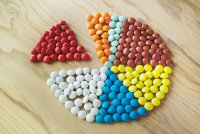The Playful Approach to Math
Math doesn’t have to be serious. One teacher believes play is the key to math comprehension for all ages.
Your content has been saved!
Go to My Saved Content.The concept of play is often limited to younger students and less academic endeavors, but play can be a useful strategy in an unlikely discipline: math.
Mathematics is known as cold, logical, and rigorous, but the subject doesn’t get enough credit for its true mischievous spirit, which is well-hidden from the world. The K–12 mathematics curricula can involve time and space to play with concepts and ideas, even in the rush of required topics.
In my research for a 2017 talk I gave at TEDxKitchenerEd called “Math Is Play,” I found few materials on the joy of math in upper grades. Much of the literature on play as a learning approach is based on the early years, particularly kindergarten, where it is an accepted pedagogical mode.
Young children at play often reach a state that psychologist Mihaly Csikszentmihalyi calls “flow,” an elusive state of mind where time seems to disappear as they focus deeply on what they’re doing. Getting to this ideal state in the classroom requires more than the freedom to play—teachers must also react to students’ ideas and guide them through concepts like counting and numbers. This type of guided play requires decision-making about how and when to give direct instruction. Creating freedom while at the same time offering direction allows for productive play that opens students’ minds to better understand difficult mathematical concepts.
The amount of play in “serious” academic topics like mathematics is inversely proportional, it seems, to the age of students, but this does not have to be the case. A playful pedagogy of mathematics can be codified and made real, rigorous, and authentic.
Embrace and Incorporate Play
In my book Teaching Mathematics Through Problem-Solving in K–12 Classrooms, I wrote about the need to accept that humans are born to play. Play is irrepressibly human, and we can play to learn. Playing and thinking are not at odds with each other. Though play is usually associated with turning off thinking and giving oneself to a pleasurable activity, working on interesting problems can be a trigger for flow. There is a sweet spot, often about 30 minutes into working on an interesting problem, where ideas start to become solutions.
Create a culture where mathematical ideas are not just formulas on a page but instead are concepts to be discussed and reasoned through. Play moves math instruction beyond rote memorization to a more expansive understanding of mathematics. Encourage students to talk, think, reason, and wonder as they move through problems. Creating a sense of curiosity, even for simple concepts, engages students in a playful way.
Simple strategies like turn-and-talk can create opportunities for collaborative, playful learning. Using prompts as part of the daily classroom routine can make mathematical concepts fun. Sites like Visual Patterns, Fraction Talks, or Estimation180 offer easy, quick ways to make mathematical concepts entertaining.
Lean Into the Unknown
Math is full of surprises that can be interesting and fun. There is no single path or strategy to the solution in many problems. Be receptive to surprises in how your students think about and solve problems. An openness to the unexpected can foster a culture of playful curiosity in the classroom. A playful mathematics learner is hopeful and optimistic—elements of a mindset that helps students improve their understanding of complex concepts.
Embrace the mess of the problem-solving process. Thinking is messy. We don’t always get things right the first time. Course corrections, revisions, and even total transformations of the work are necessary.
Observe your students as they work. Where are the roadblocks? How are they adapting to specific challenges? Listen to your own self-talk while you work, and use your challenges to think through ways your students might be challenged. Solutions are important, but so is the process along the way. Listening and talking to your students while they work allows you to give good feedback and receive assessment data.
Play creates open spaces for thinking where teachers can guide students to engage with big and interesting ideas of mathematics.
Use Concrete Methods
Physical or digital manipulatives like snap cubes, pattern blocks, and relational rods are all tools that can help students bring mathematics into being—a process called representation. Teachers can use decks of cards, dice, or counting objects to help students practice their basic skills.
For example, younger students can practice multiplication facts up to 6 times 6 by rolling two dice and multiplying the results. Older students can use decks of cards to practice integer operations, where red suits are negative and black suits are positive. For young students learning basic number skills, designate one day a week for purposeful practice using games.
Visual presentation of mathematical ideas can be playful. For example, give students a can lid or other circular object, some string, and a measuring tape to try and find the relationship between circumference and diameter.
Using physical or digital elements creates space for students to play with more abstract concepts and ideas. The freedom of a playful environment creates opportunities for deeper engagement. As I said in my talk, “Let them play. Let them talk and think and conjecture and wonder. Let them play.”
